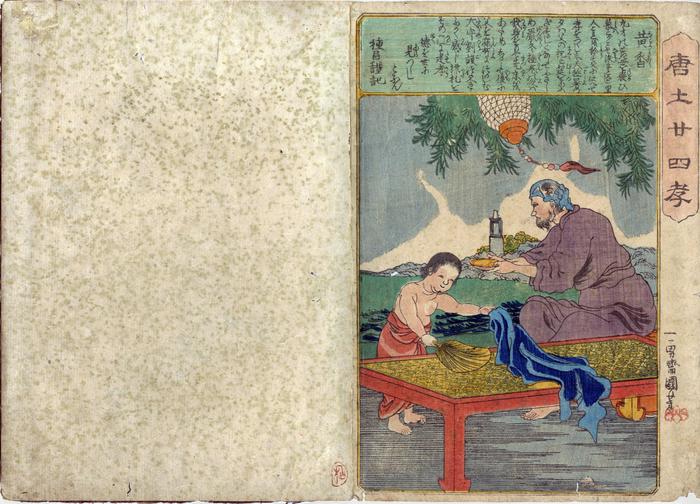Utagawa Kuniyoshi (歌川国芳) (artist 11/15/1797 – 03/05/1861)
Huang Xiang (Kōkyō: 黄香) from the series The Twenty-four Chinese Paragons of Filial Piety (Morokoshi nijūshi-kō - 唐土廾四孝)
1848
13.5 in x 9.5 in (Overall dimensions) Signed: Ichiyūsai Kuniyoshi ga
一勇斎国芳画 Seal: kiri
Inscription: Ryūkatei Tanekazu
Kuniyoshi Project - the whole series
Museum of Fine Arts, Boston
Museum für angewandte Kunst, Vienna
National Museum of Asian Art
Keio University Library
Musées Royaux d'Art et d'Histoire (via Ritsumeikan University) - trimmed
Art Institute of Chicag Below is R. Keller Kimbrough's translation of an early edition of the Nijūshikō. It does not specifically apply to these Kuniyoshi prints except in the most general terms.
[13] Ō Kyō 黄香 (Huang Xiang)
Warming the blankets in the winter monthsŌ Kyō was from a place called Anryō. He lost his mother when he was nine years old, after which he did all that he could to serve his father. Thus, in the extreme heat of summer, he would fan his father’s pillow and seat cushion to keep them cool, and in the bitter cold of winter, saddened by the chill of the blankets, he would warm them with his body before giving them to his father. Because Ō Kyō was so filial, the district governor—a person known as Ryū Kan 劉讙—set up a placard in praise of his filial piety. People say that from that time forward, everyone knew that Ō Kyō was an outstandingly filial child.
and fanning the pillows in summer to make them cool;
as a youth, he knows the duties of a child.
Since the ancient past, there has been only one Ō Kyō!
****
The book entitled The Twenty-four Paragons of Filial Piety was written by the Chinese scholar Guo Jujing during the Yuan Dynasty. His pen name was Yizi, and he is known in Japan as Kaku Kyokei. The book recounts the self-sacrificing behavior of twenty-four sons and daughters who go to extreme lengths to honor their parents, stepparents, grandparents, and in-laws. Many of the images in this series appear Western in style, rather than Japanese, and were probably copied from Italian prints. The prints in this edition appear to have been printed two per ōban sheet (about 9.5 x 13.5 inches) and folded to chūban pages (about 9.5 x 6.75 inches). The were once bound together in an album.
Japanese name: Kōkyō
Chinese name: Huang Hsiang
Kōkyō fanned his widowed father to cool him in the summer and warmed his father’s bed with his own body in the winter. Here Kōkyō is preparing his father’s bed.
Robinson: S60.13
[The above English-language information is all taken directly from the Kuniyoshi Project.]
****
There is another copy of this print in the British Museum.
****
The text was composed by Ryūkatei Tanekazu (柳下亭種員: 1807-58).
Historical - Social - Ephemera (genre)
Fushimiya Zenroku (伏見屋善六) (publisher)
Ryūkatei Tanekazu (柳下亭種員 - 1807-58) (author)
Nijūshikō (二十四孝: The twenty-four filial exemplars) (genre)
